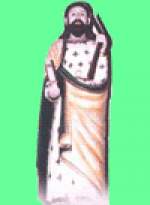History of Koilparampil (Coilparampil) Family - Part 2
Historians interpret the name Arthunkal differently. One version is that the thatched chapel built initially was at Arthikulangara and later the name was modified as Arithikulangal, Arthunkal and Arthunkal. Another version is that the "Siva" temple of the Puliankottu family used to conduct the 'Arattu Ulsav every year. The distance from the temple to the sea where Arattu was conducted came to be known as Arattunkal and later became Arthunkal. The third interpretation put forward by the historian and scholar Shurhamer is that this place was the capital of the small kingdom 'Moothedathu', called Moothedathunkal, gradually Moothdathunkal became Edathunkal, which in course of time got modified into Arthunkal.
Second church built in Cherthala taluk was at Manapuram (Pallippuram). The Marthoma (Chaldaic Christians) at Arthunkal used to go there for their religious rites. When the Muttom church was founded in 1023, they stopped going to Pallippuram and went to Muttom church instead, as it was comparatively nearer. It is recorded in the history of the Muttom parish that certain members of the Koilparampil family had been the trustees of the Muttom church. Rev.Fr.Dominic Koikara, of Kanjoor, who was the vicar of Muttom church has also, mentioned this fact in an incident. Years before Mr.Mathew M.Panat in his book, 'Irulile Rajatharekha' has written that certain families of the Arthunkal parish has claimed to be the former members of the Muttom church. In 1579 when the Muthedathu, Elayidathu ruler gave permission to build churches, the forefathers of the Koilparampil family built a Thatched chapel of the muttom Church facing north in the name of St. Thomas. There they kept the Holy cross and the statue of St.Thomas and began worship (This St.Thomas Statue is kept in the south alter, in the new church)Latter in this chappel The Sunday mass was conducted by muttom church Priests.
Later by the arrival of the Portuguese in 1581, the Portuguese Bishop Dom Matheeus Demadina built a church made of wood in the name of 'Santhanthraos' in the place of the thatched chapel, and entrusted its administration to the Koilparampil family. This is handed down by generations even to this day. So the family members were compelled to conform to the Latin rite. Bishop Michael Arattukulam in his booklet "St. Francis on the Malabar coast" page 16 speaks about the adoption of the Latin Rite. The foundation of the above mentioned church was mentioned in the book 'A peep into the history of the Cochin diocese by Fr.Joseph Naduathumuri. And in another book 'Kerala Rajyathile Satyaveda Charithram' by Maseleenus, the church made of wood and Palm leaves is mentioned (page 80). Rev. Fr. Paul Arackal in his book 'Arthunkal Veluthachan' has mentioned about the Marthoma Christians of Arthunkal who worshiped St.Thomas, centuries ago in (Page 9).
When St. Francis Xavier arrived at Goa in 1540; he converted many of the native's into Christians. When he came to Kerala he avoided the area from Kochi to Purakkat from his mission work. Perhaps it was because of the Marthoma Christians who inhabited these areas. The Portuguese missionaries established "Santharthre mission" and forced the Marthomite Christians to accept the Latin rite. In 1590, Fr.Finiceo built a Church of stone. Later in 1640 Fr. Fossaseka rebuilt it facing towards West.
In 1647, the statue of St.Sebastian was placed. In 18th century, the church was taken charge by Carmelite missionaries from Jesuit missionaries. During the Carmelite service on 29th November 1829, blessed Chvara Kuriyakose Ealiyas was ordained by Rt.Rev.Dr. Stabalini, the Bishop of Verapoly, who was residing in Arthunkal St.Andrew's church). Thence forward a multitude of people visit the Church especially during the feast of the Saint Sebastian to share his blessings.
as the worshipers increased in number, so did the income of the Church. The increasing in income provoked the Portuguese representative and his assistants to do some misdealing in money matters. The natives, Koilparampil, Puthenpurackal, Charankattu and Arackal families threw them out, and in 15 Nov 1866, they built another Church. Such is the history of Aruthunkal.
I am not of the opinion that I have written this book after closely examining all the historical manuscripts. I have written this on the basis of some of the manuscripts available. If anybody is willing to furnish more details, I am ready to make sufficient changes in any further editions.
Family Genealogy
Total live descendant families = 384
Example = 3.K.F.2/G.9 (2)
Family = F, Generation = G, Koilparampil = K, Tharavad (Father's home) = T
All first no. = Branch Number. Koilparampil Family serial nos. (Example = 3.K.F.1, 2, etc.)
Generation nos. (Example = G1, 2, 3, etc.) Branch 3.Tharavad Family serial nos.
(Example = [3.T.F.1, 2. etc.] Forefathers serial nos. = K1 to K9.
K. THOMMEN KOILPARAMPIL from Palayur, had settled at
MACKEAKADAVU at MANAPURAM), Cherthala
K1.G1. 1, Chory (Settled at Elainji)
(K2) G1. 2, Anthay
K1.G4 Some of the descendants of Chory had shifted at ELAINJIMEL near Cheriyanad in the Alappuzha district. These families are Orthodox Christians. Others are migrated to other families Branch 1:
K1/G8.CHERIYAN (K1.Chory's descendant.) (2.K.F.1) Branch 2:
K2/G1 (2).ANTHEY (ANTONY) [T.K.1].
G2.1, Thommy.K3
K3/G2 (1) THOMMY [T.K2.]:
G3.1, Vasthyan (K4).
G3. 2, Vathan (3.K6.) Branch 3
K4/G3 (1) VASTHYAN [T.K3.] G4.1, Visenthy (K5)
G4.2, Anthey (4.K7) Branch 4
K5. /G4 (1) VISENTHY [T.K4.].
G5.1, Ouseph (5.K8) : Branch 5
G5.2,Vathy (6.K9) Branch 6
